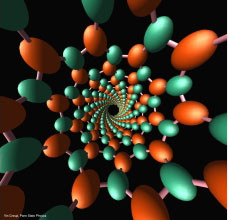Nanotechnology in Medicine – An Overview
Nanotechnology is the engineering of functional systems at the molecular scale. This covers both current work and concepts that are more advanced. Nanotechnology enhanced materials will enable a weight reduction accompanied by an increase in stability and an improved functionality. Biomedical nanotechnology, bionanotechnology, and nanomedicine are used to describe this hybrid field. The prefix "nano" refers to one-billionth. When applied in the metric scale of linear measurements, a nanometer is one-billionth of a meter. The term "nanotechnology" is now commonly used to refer to the creation of new objects with nanoscale dimensions between 1.0 and 100.0 nm.
The whole 15 pages article is available for download here.
Functionalities can be added to nanomaterials by interfacing them with biological molecules or structures. The size of nanomaterials is similar to that of most biological molecules and structures; therefore, nanomaterials can be useful for both in vivo and in vitro biomedical research and applications. Thus far, the integration of nanomaterials with biology has led to the development of diagnostic devices, contrast agents, analytical tools, physical therapy applications, and drug delivery vehicles. Nanotechnology is also opening up new opportunities in implantable delivery systems, which are often preferable to the use of injectable drugs, because the latter frequently display first-order kinetics (the blood concentration goes up rapidly, but drops exponentially over time). This rapid rise may cause difficulties with toxicity, and drug efficacy can diminish as the drug concentration falls below the targeted range. Nanotechnology can help to reproduce or to repair damaged tissue. This so called "tissue engineering" makes use of artificially stimulated cell proliferation by using suitable nanomaterial-based scaffolds and growth factors. Tissue engineering might replace today's conventional treatments like organ transplants or artificial implants Much of nanoscience and many nanotechnologies are concerned with producing new or enhanced materials. Nanomaterials can be constructed by 'top down' techniques, producing very small structures from larger pieces of material.
Nanotechnology is the study, design, creation, synthesis, manipulation, and application of materials, devices, and systems at the nanometer scale (One meter consists of 1 billion nanometers). It is becoming increasingly important in fields like engineering, agriculture, construction, microelectronics and health care to mention a few. The application of nanotechnology in the field of health care has come under great attention in recent times. There are many treatments today that take a lot of time and are also very expensive. Using nanotechnology, quicker and much cheaper treatments can be developed. By performing further research on this technology, cures can be found for diseases that have no cure today. We could make surgical instruments of such precision and deftness that they could operate on the cells and even molecules from which we are made - something well beyond today's medical technology. Therefore nanotechnology can help save the lives of many people. Nanotechnology, when used with biology or medicine, is referred to as Nanobiotechnology. This technology should be used very carefully because the lives of human beings are being dealt with. If used properly, it can be very effective in providing treatments with minimal side-effects. Nanomedicine, an offshoot of nanotechnology, refers to highly specific medical intervention at the molecular scale for curing disease or repairing damaged tissues, such as bone, muscle, or nerve. A nanometer is one-billionth of a meter, too small to be seen with a conventional lab microscope. It is at this size scale - about 100 nanometers or less - that biological molecules and structures inside living cells operate. Nanotechnology involves the creation and use of materials and devices at the level of molecules and atoms. Research in nanotechnology began with discoveries of novel physical and chemical properties of various metallic or carbon-based materials that only appear for structures at nanometer-sized dimensions. Understanding these nanoscale properties permits engineers to build new structures and use these materials in new ways. The same holds true for the biological structures inside living cells of the body. Nanotechnology in medicine currently being developed involve employing nano-particles to deliver drugs, heat, light or other substances to specific cells in the human body. Engineering particles to be used in this way allows detection and/or treatment of diseases or injuries within the targeted cells, thereby minimizing the damage to healthy cells in the body. Nanotechnology can be defined as the science and engineering involved in the design, synthesis, characterization, and application of materials and devices whose smallest functional organization in at least one dimension is on the nanometer scale or one billionth of a meter. At these scales, consideration of individual molecules and interacting groups of molecules in relation to the bulk macroscopic properties of the material or device becomes important, since it is control over the fundamental molecular structure that allows control over the macroscopic chemical and physical properties. Applications to medicine and physiology imply materials and devices designed to interact with the body at subcellular (i.e., molecular) scales with a high degree of specificity. This can potentially translate into targeted cellular and tissue-specific clinical applications designed to achieve maximal therapeutic affects with minimal side effects. In this review the main scientific and technical aspects of nanotechnology are introduced and some of its potential clinical applications are discussed.
The whole 15 pages article is available for download here.

